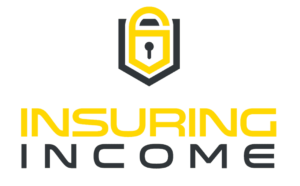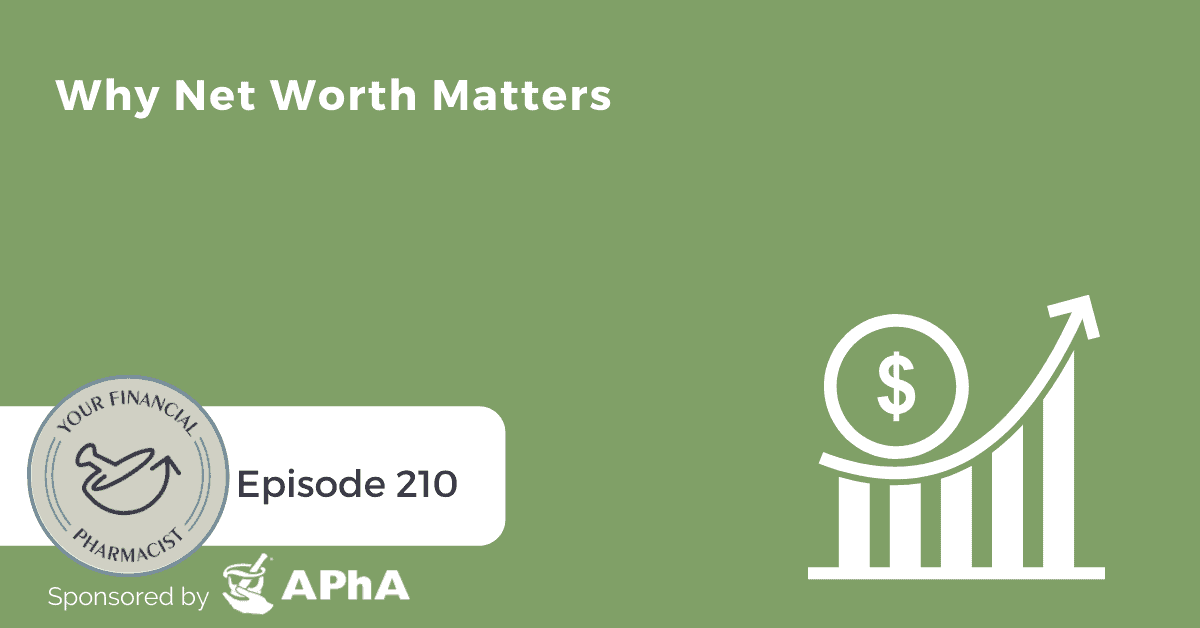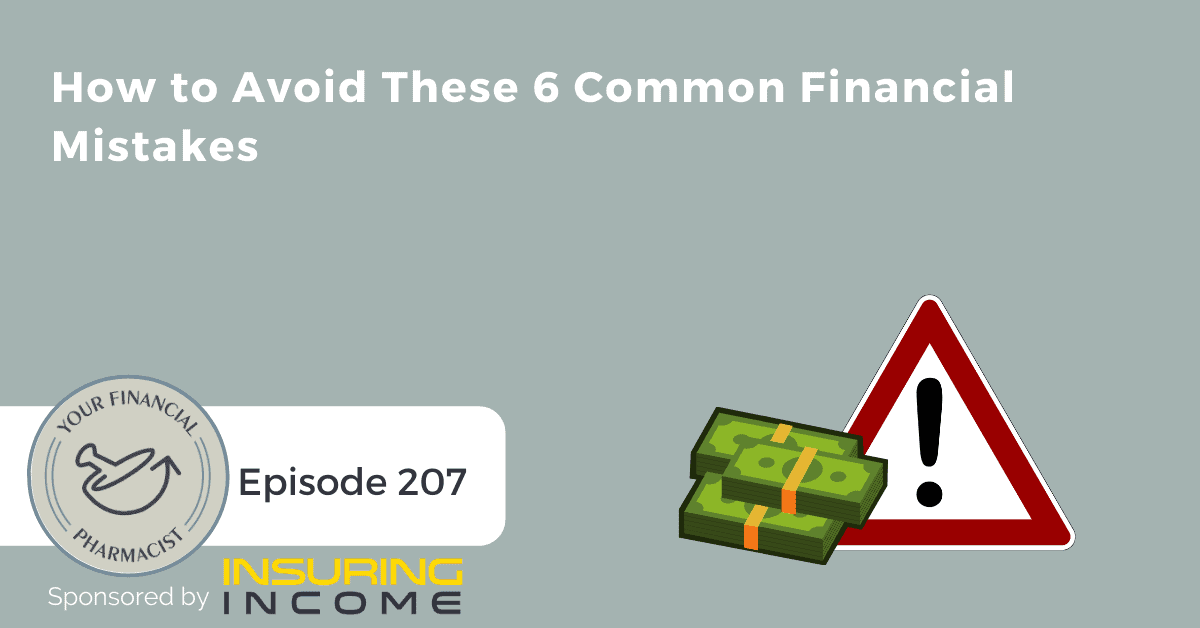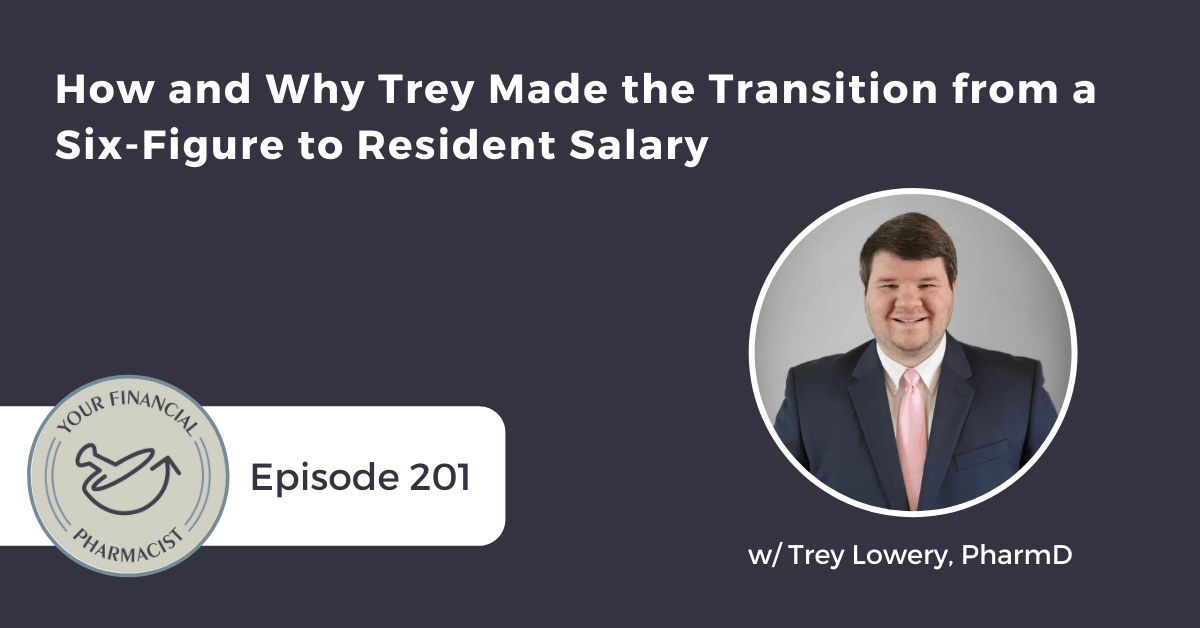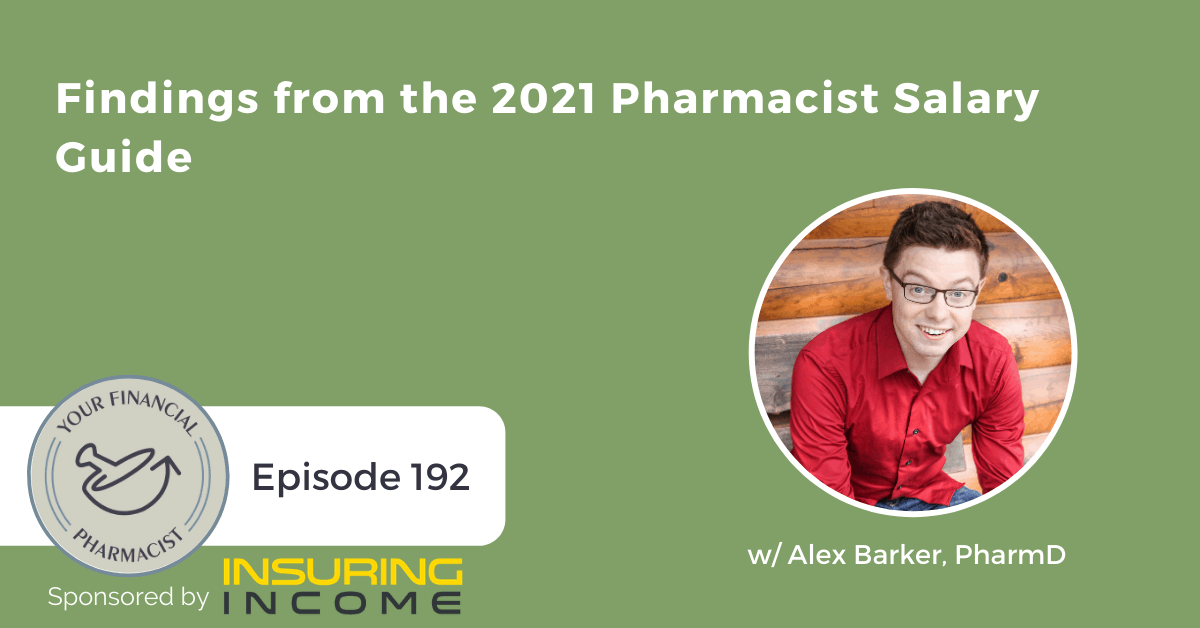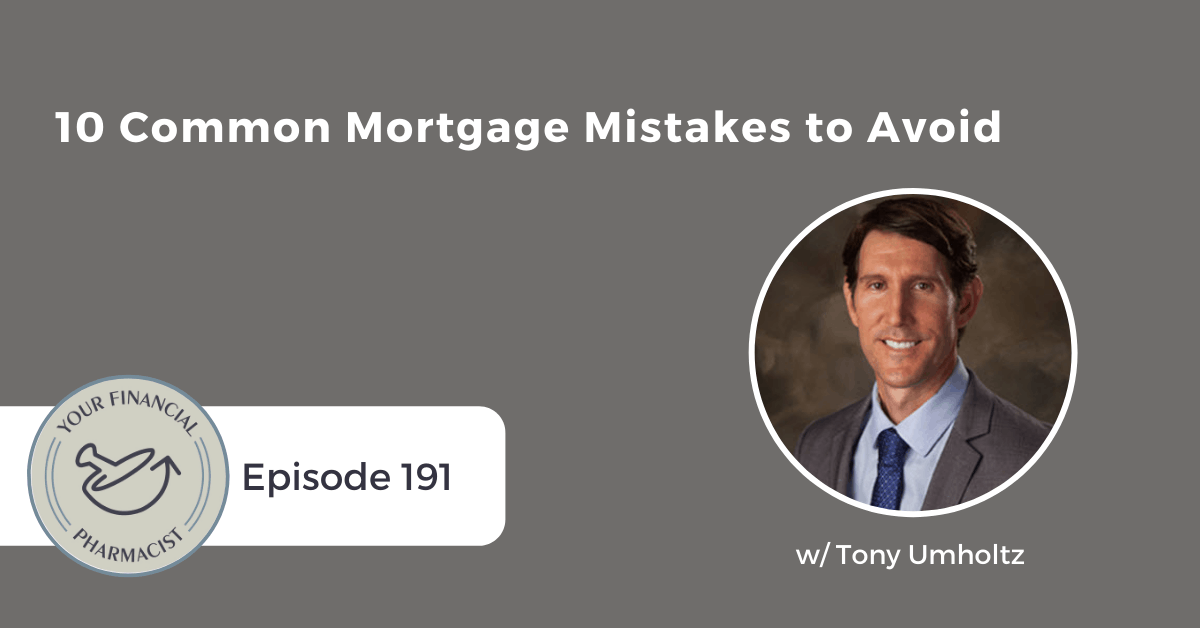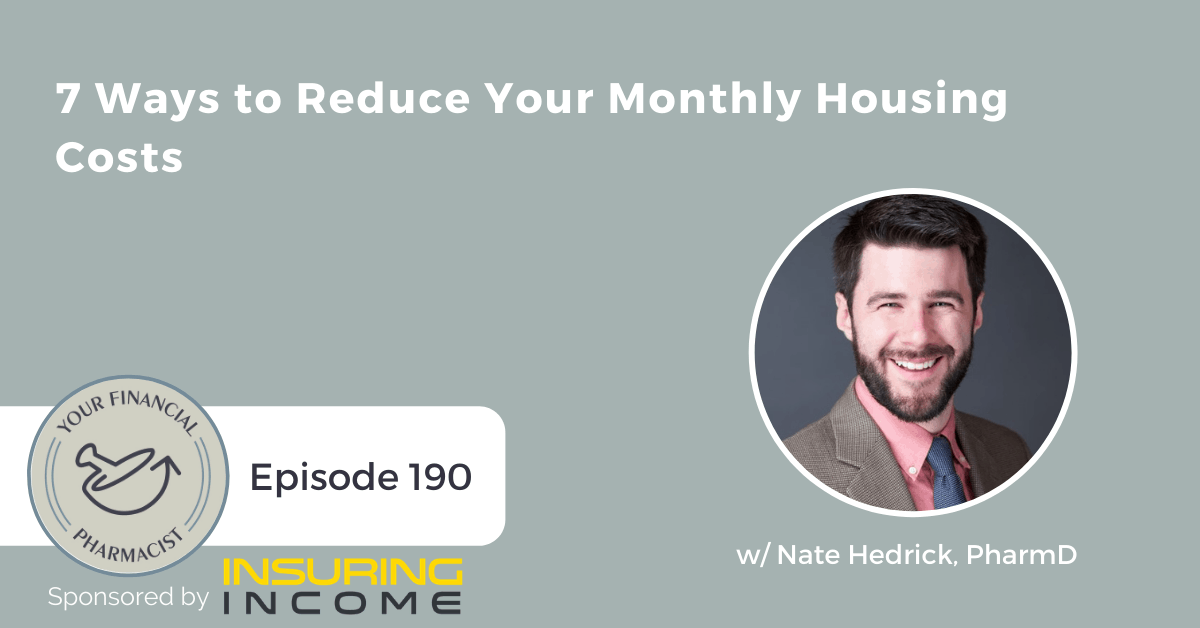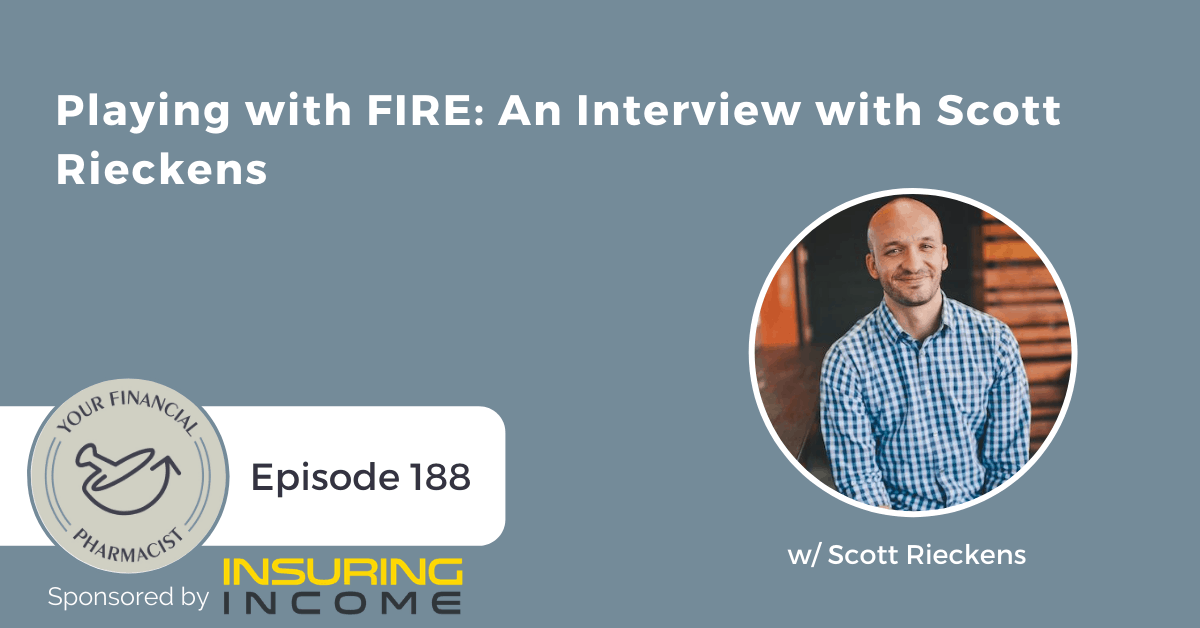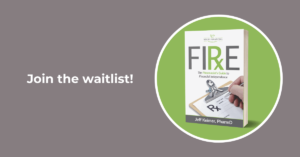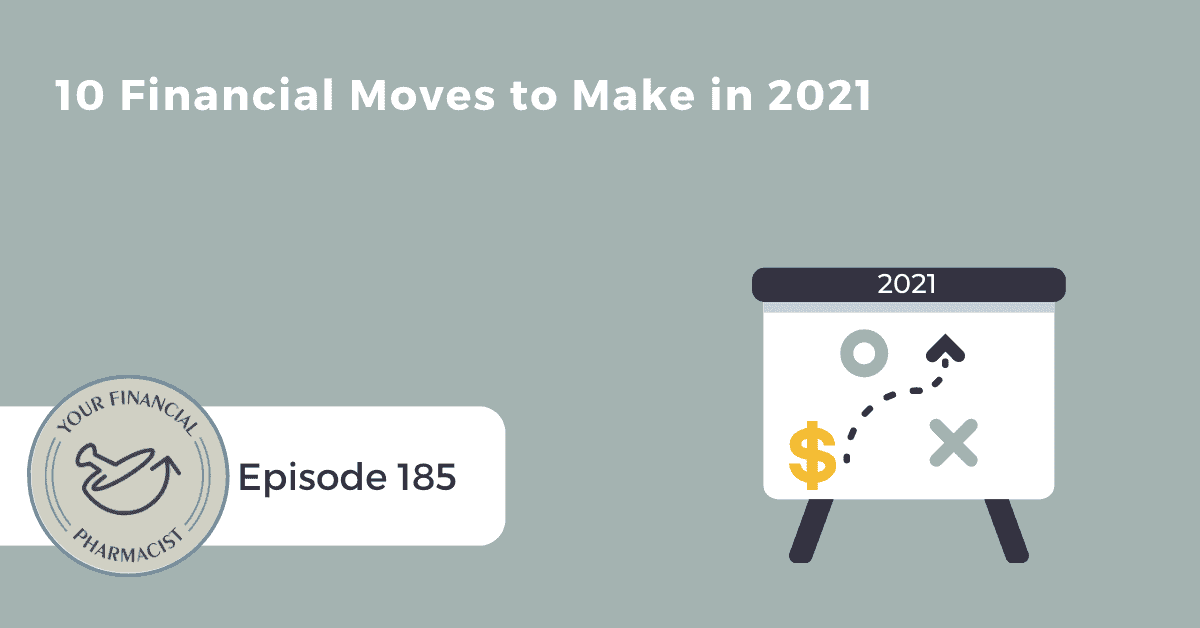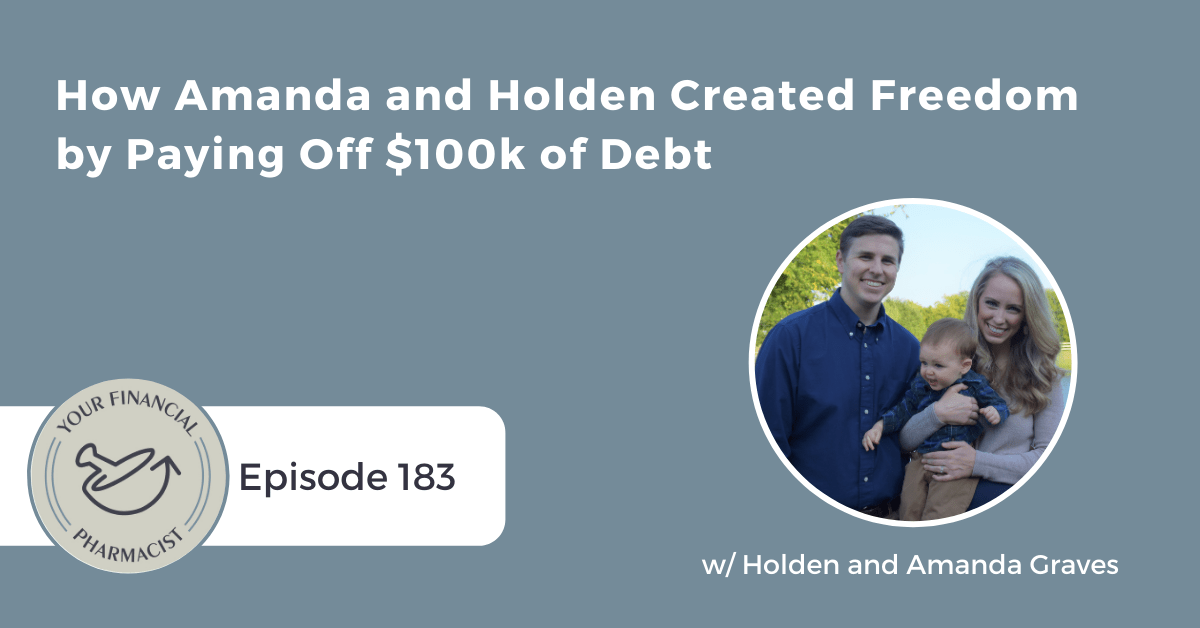The Ins and Outs of the 529 College Savings Plan
On this episode, sponsored by Insuring Income, YFP Co-founder and Director of Financial Planning Tim Baker takes a deep dive into the 529 plan. He discusses a framework for how to project and save for kids college along with the construct of 529 plans including what they are, tax advantages, what are qualified and non-qualified expenses, and considerations when investing money within a 529.
Summary
Pharmacists are well aware of how expensive college costs and that paying for it is no easy feat. The average student loan debt load pharmacists graduated within 2020 was $175,000 and the cost of college will likely continue to rise. The 529 college savings plan is a tax-advantaged account that is an option families are using to help get in front of the cost of college.
Tim shares that he and his wife are saving an education nest egg for their two children, however, they are not going to forgo saving for their own retirement or other priority financial goals. When it comes to advising YFP Planning clients, Tim mentions that it really is a personal preference; some clients want to completely fund their children’s education expenses, some want to support in a small way, and others aren’t interested in putting money away to pay for it. Tim shares a framework that folks can follow if they are interested in helping their kids pay for college but aren’t sure where to pull the money from. The framework follows a three-bucket rule where the first third of the money for college comes from your current salary (which is really your future salary at the time your child is in college). The second third is made up of money that you’ve saved in the past such as from a 529 plan, brokerage account, savings account, Roth IRA, etc. The final third is money from scholarships, grants, and loans that your child will/can receive.
Tim also talks about the ins and outs of the 529 plan and answers some questions asked in the YFP Facebook Group.
Mentioned on the Show
- Insuring Income: Get Quotes and Apply for Term Life and Disability Insurance
- Register for the Next Webinar: Home Buying for Pharmacists: What to know, how to determine if you’re ready, finding an agent, financing, and more!
- YFP 195: How to Save for Your Child’s Education
- 7 Things to Consider Before Starting a 529 Plan
- YFP Planning: Financial Planning for Pharmacists
- Join the YFP Facebook Group
- YFP 208: Why Minimizing Fees On Your Investments is So Important
- Schedule a free Discovery Call with YFP Planning
Episode Transcript
Tim Ulbrich: Tim Baker, deep dive on 529s. Are you ready?
Tim Baker: Let’s do it. Yeah, excited.
Tim Ulbrich: So this is a follow-up from Episode 195, so we talked about saving for kids’ college in that episode. And we’re going to link to that in the show notes. But we wanted to dig deeper on 529 given that a number of our clients and the YFP community members are at various stages of kids’ college planning, some perhaps on the front end, just getting started, others on the back end, you know, distributing those funds or maybe even some further along that are helping with the grandkids or other family members’ college savings. So we want to dig deeper into the 529. We also had a recent blog post by Dr. Jeff Keimer on seven things to consider before starting a 529 plan on the YFP blog. Make sure to check that out. We’ll also link to that in the show notes. And here, we’re going to dig into some common questions that come forward as it relates to college savings. Now, we don’t need to tell this group about why college savings is necessary. I think many pharmacists are well-versed in student loan debt, unfortunately. Average graduate in 2020 faced about $175,000. This is a $1.7 trillion problem that we have as a country. And so obviously the goal with 529 savings is to try to get out in front of that. Tim, tell us from your perspective, obviously a parent of young children yourself, what is your personal thinking, your framework for saving for kids’ college. And not only how you think through this for your own children but also ultimately guide some of our clients at YFP Planning.
Tim Baker: Yeah, so it definitely is a — it definitely is a personal preference, Tim. So like I can kind of share with you my own and then kind of what I hear from clients. So you know, when I grew up in the great state of New Jersey, the Garden State, way back in the day, my mom was a teacher, my dad worked for a chemical company, Rohm and Haas in Center City, Philadelphia. And basically, the message to us was, ‘You’re on your own, kids. Like figure it out.’ And that kind of — I think it was partly to light a healthy fire under our rear end to make sure that we were good in school and we got scholarships and we just put ourselves in the best position to pay for school. They ultimately I think did help my siblings. So I think a lot of it really stems back to like how you were kind of raised in terms of your own parents and how they brought you up. So some people, they — it’s par for the course, they do the exact same thing that their parents did. And some people are the exact opposite. Or if you overlay kind of the horrid state of higher education and what it costs and what it’s doing to a lot of pharmacists coming out of school, that also plays a part. So I’ve heard everywhere from, ‘My kids are on their own,’ to, ‘I don’t want my kids to ever have to go through what I’m doing.’ So I would like a 100% solution for undergrad and also postgraduate school. Because a lot — you know, unfortunately, a lot of the pharmacists that we work with, I hear this — I don’t know if you hear this, Tim, when you’re speaking to prospective clients of YFP is — ‘Yeah, I didn’t really have many loans coming out of undergrad but then when I hit pharmacy school, now I have $150,000, $175,000, $200,00.’ So a lot of people are like, ‘Yeah, I would just like to get through my kids’ undergrad, but that doesn’t necessarily solve the problem. So me personally, Shea and I when we look at our kids, Olivia and Liam, Olivia who’s 6 and Liam who’s about to turn 2, it is definitely an exercise too that we want to help them as much as we can. And we want to be able to have a good education nest egg, so to speak, there for when they do go to school if they decide to go to school. But we are not on the one side of the spectrum where we’re going to forgo things that we want to do today, our own retirement, etc., just to hit that goal. So it’s a personal preference, though. I’ve actually heard of clients say like, ‘We’re just going to have the one kid because of the education and we want to basically put them in the best situation as possible.’ That’s a preference. What I’ve found in most cases is that clients have a semblance of kind of like what they want to do, but they have really no idea of how to actually go about like setting up an account or funding it or all of kind of the ins and outs of that. And that’s obviously some of the things we’re going to talk about today.
Tim Ulbrich: Yeah, and one of the things that I like — and again, we’re talking just basics here in a general framework. And a shoutout here to Kelly Redy-Heffner, one of our lead planners at YFP. You know, she mentioned a framework, a third, a third, a third, which to your comment, you know, there is no one right answer when it comes to kids’ college savings. So keep in mind as we talk about these buckets, but I think this is a good just general framework that folks can wrap their arms around and begin to think about alright, I like that, I don’t like that, or how do I modify that for my own personal situation. So tell us about what those buckets are, Tim, when we say a third, a third, a third for college savings.
Tim Baker: Yeah, so you know, one of the components of education planning is the funding aspect. We’ll talk about the vehicle with the 529 here more so. But the funding aspect is super important. So what the 1/3 Rule states is essentially that — and these are, this is typically like what we put in front of clients if they don’t really know what they want to do. But then once we have this as kind of our rule of thumb, then this is how we basically design the plan around it and actually show them the numbers of what they need to do. So the ⅓ Rule states that when you look at the tuition and fees and all the expenses related to going to college, we want to basically divide up where that money is coming through by really into three buckets. So the first bucket or one-third of the money is going to come from current salary. So what that — so we say current, but we actually mean future salary. So example: When Olivia, my daughter, is 18, so 12 years from now, whatever money I’m making and Shea is making, one-third of that we would cash flow to wherever she’s going in terms of tuition. So that’s the first bucket. The second bucket is basically what we’re going to be talking about today is what’s saved, you know, in the past. So this is like the 529 account, this is maybe a brokerage account, a Roth IRA, a savings account, a piggy bank, maybe an investment property that you invested in, so all the different kind of creative ways that we’ve basically saved and invested money over the course of the child’s life. So that’s the second bucket. And then the third and final bucket would be the scholarships, the grants, the financial aid or even the loans that that is student receiving as they’re going to college. So one-third for kind of cash flow in the moment, one-third from what we save and invest in over the course of the child’s life, and one-third from grants, scholarships and aid and debt — aid and loans to kind of basically put that picture together.
Tim Ulbrich: So let’s jump into the 529 plan, Tim, a little bit further.
Tim Baker: Yeah.
Tim Ulbrich: And give us the high-level, 101 definition of a 529 plan.
Tim Baker: So the way that I look at a 529 plan, a 529 plan is basically, it’s like a 401k or an IRA for your education. So the idea here is that you set money aside into an account that you typically fund with after-tax dollars — now, some states allow deductions and even credits to fund a state plan. So you fund it with after-tax dollars. Those dollars grow tax-free. And then when you distribute them for the purposes of higher education or even K-12 now, they come out basically tax-free. So one of the big things that we often throw around is like, what’s this whole thing of growing tax-free? So some people are like, ‘Well, why wouldn’t I just invest this or save?’ So to kind of just illustrate this point, if you are in a tax-advantaged account like a 529, when you invest — say you buy inside of that account a XYZ mutual fund. So you buy that at $100, Tim. And over the next — so you buy that right in the year of your kiddo’s birth. So that particular mutual fund over time, over those 18 years, is going to go from $100 to $200 to $500, whatever the share price is. And then say in 18 years, you sell it for $500. If it is outside of an account like an IRA, like a 529, and it’s in a brokerage account, a taxable account, you have to pay tax on those capital gains. So in this case, $400 per share times the amount of shares that you have. So the tax bill on that can be pretty prohibitive in terms of like what is actually left for you outside of paying Uncle Sam. So obviously if it’s held for a long period of time, you have long-term capital gains, which for most pharmacists is going to be about 15%. So inside of a 529, you don’t have capital gains. You basically — that’s the tax advantage, that it can grow from $100 to $200 to $500 — and that $400 gain, as long as it’s inside of that account, you don’t pay tax on. That’s the beauty of the 529. Now, the problem is a lot of people are like, ‘OK, what’s the catch?” Right? So for retirement plans, you can’t take it out unless you’re a certain age and all of these other things. And for education, there are some drawbacks. One is if you distribute it that are not for education costs, there’s a 10% penalty. You know, you do have to pay the taxes on it, etc. But if you do use them for qualified expenses, then that tax advantage holds true.
Tim Ulbrich: Good breakdown. I think sometimes we just throw around terms like tax-advantaged and so forth. So that’s really helpful. And I’m going to jump into some common questions I think that come up that folks may have about 529 accounts. And some of these are going to be coming from YFP community members who have posted questions in the YFP Facebook group. And I think these questions all fit into one of two areas. When I think of 529, there’s really two phases for saving for kids’ college. And this feels very similar to how we think about saving for retirement. And that’s the accumulation phase where we’re trying to fund the future need. Here, we’re talking about the cost of college. And then there’s the withdrawal phase, and then we get into different concepts and perhaps questions around there as well. And you already outlined some of the tax advantages, and I think that’s probably one of the most common questions, and you mentioned how the taxes can work in terms of that tax-free growth. And then as long as we’re using them for qualified expenses, we can pull them out without penalty. And then you also mentioned that many states offer some type of state income tax deduction or credit. And I just wanted to give folks one example of that. Here in Ohio, in the great state of Ohio, Ohioans can deduct their Ohio 529 contributions from their Ohio taxable income up to $4,000 per year per beneficiary. So you know, when you’re talking about that from a state savings, is that huge sums of money? Not necessarily, but you know, every little bit helps in terms of what you might be able to save on some of your state taxable income. So Tim, let’s talk about qualified and unqualified expenses. So we want to make sure, of course, that if we’re saving this money — you mentioned what’s the catch? — if we’re saving this money and it’s growing and we’re ultimately going to put it to its best use and not have to pay penalty, we want to make sure that we’re thinking about what is qualified and what is not qualified. So walk us through some of the common qualified expenses and some of the common nonqualifying expenses.
Tim Baker: Yeah, so you know, typically the things that you think of that are qualifying are kind of the common things. So that’s going to be like tuition, room and board, fees associated with tuition, that type of thing. And it could be food, it could be textbooks, transportation, those are — actually transportation is not. Sorry, transportation is not typically part of that. But these are books and supplies. It could be expenses for special needs. A lot of the computer and technology and internet, those are all under that. And that has kind of changed over time. So a lot of it is — and I suspect, so like one of the things that people kind of get tripped up on, Tim, is like, ‘Well, you know, I would like to do this, but I feel like it’s too restrictive..’ And even in our lifetime, you know, in really the next last 10 years, they’ve become more — or they meaning the government — has become more and more less and less restrictive in terms of what these dollars are for. So like as an example, you used to not be able to use it for trade school and things like that. Now you can. You used to not be able to — which is crazy, and they even still cap it, which I’m not sure why they do this — but you used to not be able to pay — if you had money in a 529, you couldn’t use it to pay your loans without — that was an unqualified expense, which is crazy. Now you can. I think the cap is $10,000.
Tim Ulbrich: $10,000. Yep.
Tim Baker: So the use is broad, and I expect it to be more broad in the future. The other big thing that has changed with the 529 that has really allowed to open up other doors is you can now use it for K-12 expenses. So Tim, if you ever were to decide to send the boys to private school, you can actually use that. In a lot of cases, it’s less of an accumulation, it’s more of a pass-through because obviously your boys would be going through school now. But if you were to — if you wanted to set up a 529 for grandkids for K-12 or even their college, it would be more of an accumulation. So in terms of qualified expenses, it’s fairly broad, and I think it’s going to continue to broaden as we go, even as more nontraditional ways of education sprout up. I think that the 529 will be — I anticipate that they’re going to continue to try to find ways to mitigate this issue with just rising expense and debt levels, etc.
Tim Ulbrich: Yeah, I agree with you. I think if anyone’s been following along in the national conversation around student loan debt, I think it feels like we’re in a direction towards, ‘What can we do to try to minimize that?’ And I think one way might be to loosen up even further, although to your point, it’s come a long way in terms of 529 qualifying expenses. Tim, what are some other downsides — if any — to the 529 that folks might want to consider beyond potential penalties for nonqualifying expenses. We’ll talk in a moment about, ‘Hey, what if my child doesn’t end up going to school?’ and using this. Any other downsides that come to mind that folks would want to at least consider and evaluate as they’re making this decision?
Tim Baker: Yeah, so some of the downsides would be, you know, not being able to use the dollars for like what we would consider unqualified expenses, which might be like college application and testing fees, which we know can be fairly high. It could be you can’t use them for transportation, health insurance, extracurricular activities, and some room and board costs, which again can add up. So that’s one of the things that’s a downside. I think the other thing would be the fact that, you know, because you have to use it for higher education and if your kid doesn’t go to college, like what do you do with the money? So I think that you don’t lose the money. I think some people think like, if I put that in and they don’t go to college, I can never get it back. At a minimum, you would take a haircut, a 10% penalty and pay the taxes on those gains, and that wouldn’t necessarily be ideal. But you could think really beyond traditional college. So again, I think as the government continues to look at this, whether it’s helping another college with K-12 or re-assigning the 529 or basically changing the beneficiary from one kid to another, you can do that. You can transfer it to another account. It could be going back to college yourself. Like if you decide — if a kid decides that they don’t want to do this, you can use it for that. Or at a minimum, you can withdraw it. So I think if there is an iota — and again, not advice — but if there is an iota that your kid is going to do something post-high school, I would plan for it. And a lot of the — I think it also depends on the state because of the state deductions will incentivize that. But even like the tax benefit of growing it tax-free, if you’re looking at 18 years, if you’re looking at 10 years, that’s a real period of time where you can get a lot of gain out of an investment account and to be able to direct. And it could be a legacy, Tim. It could be a legacy thing, Tim. Like Liam, like if Olivia doesn’t want to go to school or say she gets accepted to West Point and we don’t need it because there is no tuition, it’s just time service, we would basically shuttle that off to Liam. Liam would get the account. But then if he decided he wanted to start a business or things like that, I think what I were to do in that moment — unless I really needed to use the cash — I would look at my nieces, my nephews, I would potentially look at it as a legacy thing to send my grandkids to college.
Tim Ulbrich: Yeah, let it ride.
Tim Baker: Yeah, let it ride. Just let it do its thing. And you know, allow that to be a legacy thing for me that I know we have clients that — the lucky few that get through pharmacy school that’s like, ‘Oh, my grandma and my grandpa sent us.’ Like I would love to be able to give that gift. I’m not thinking about that, that’s chess right now. I’m really trying to think about our kids. But if that situation would arise, I would take that one-third pool of money that we’re working towards and either repurpose it for the other child or look at the next generation.
Tim Ulbrich: Tim, you know, I often say when I’m speaking with a group about kind of Investing 101, that when it’s something like a 401k or an IRA, Step No. 1 is you actually put the dollars in. Step No. 2 is then you actually figure out what you’re going to do once those dollars are in the account. Same thing here, right? We’re talking about money that hopefully is going to grow over time, which means we’ve got to have some thought and intention to how we’re investing that money. So clearly, this is not meant to be investing advice inside of a 529, but just talk to us about how you think through that or how you work through that process with clients of, you know, it’s great we’re saving. But now we’ve got options. And how do we evaluate that and is that just a very similar process to what we’d be thinking about as we would in a 401k or in IRA or even in a brokerage account?
Tim Baker: So yeah, so this is another big piece of like now that we have — like we’ve identified what we want to save and in this case, we’re talking about the 529 so that’s kind of the organization of the account. The second piece is kind of the contribution/funding of it. But really, the last piece is kind of the allocation. And this is kind of how we break down recommendations for clients. And again, it’s going to dependent on their situation, their goals, the state they live in, their tax situation, etc. The allocation piece is just like retirement plans, 401k’s, the by-and-large most popular thing that we see is the target date fund. The target date fund says, ‘OK, if my kid is going to go to school in 2030,’ it basically has an allocation that changes over the year. So it goes from more equity-focused the further out and then basically changes and alters itself as it gets closer to that 2030 timeline and becomes more bond-focused. So the target date fund for 529s, you know, that’s basically how it works. Personally, I don’t like target date funds, not because they don’t work. They do. But more so because they’re more expensive. So you know, for our kids, we just use like a total market. So the Maryland 529 — we’re moving everything over to Ohio now — you know, there’s a total market fund that we use that we want to be super aggressive and then as Olivia gets closer to her, I’ll just do that manually. Now I do that because that’s what I do for a living. Some people, if it’s kind of out-of-sight, out-of-mind, they’re not working with an advisor, they maybe should look at a target fund. But just know that dollars are going to be a little bit higher in terms of expense ratio and things like that because they’re doing that work for you. So I think the other thing too from — the reason I don’t like target date funds in particular with regard to retirement is that a lot of people, the retirement date is a little bit more — it’s more of a moving target whereas not so much with college. Most of the time, a child graduates high school and they’re going to be off to college the next year. But that could be another reason that you don’t necessarily look at the target date fund. But yeah, when you look at most 529s — and again, the 529s are not created equal. There are some that are really good, meaning they offer good — or they offer an array of investments that are out there that are cheap. Some, there’s a lot of fees and higher expense ratios that are not necessarily great for the investor. So a lot of that is dependent on the type of plan that you’re in and where you’re at.
Tim Ulbrich: Hey, that sounds like an episode we just did recently on not all investments are created equal in terms of fees.
Tim Baker: That’s right.
Tim Ulbrich: So same thing here.
Tim Baker: That’s right. Yep.
Tim Ulbrich: Tim, one of the questions we had from the Facebook group, Ernesto asked, “Can you start these for nieces and nephews?” as one example. I guess others may think of the same thing for grandkids. We talked about the transfer of them, so you used the example if Olivia or Liam doesn’t use it that you might be able to transfer it to your nieces or perhaps in the future grandkids. What about actually starting or opening an account for a niece, nephew, grandchild, etc.?
Tim Baker: Yeah, you can absolutely do that. And I think maybe a downside is how it affects financial aid. So you know, the — it does affect financial aid when it’s owned by a parent. But the benefits that you receive, it’s going to be very slight how it affects financial aid. For a child, you definitely don’t want to have it in — the ownership in the child’s name. But for someone like an uncle or a grandparent, I don’t even think it’s on the radar. So yeah, you can absolutely do that, get your tax deduction too as you go, which is nice. In terms of like changing ownership, you know, you can do — I think you can do a rollover, so I can move money from Olivia to Liam. I think you can do that partially. You can do a partial rollover, or you can just do a straight beneficiary change where you’re saying that this account is no longer for Olivia, and now it’s for Liam. So I think there’s a wide variety of how you can kind of manipulate that, which gives you kind of maximum flexibility to kind of get the most out of the plan.
Tim Ulbrich: Another question we had was from Casey, which is one that I have heard before. So I know this comes up often. And in addition to giving a shout-out to Kelly Redy-Heffner, which was pretty awesome, Casey asked, “Main question is 529 v. IRA. Should I instead put the money in an IRA so I can have more options to invest, also more flexibility if continuing education is not desired and take out only the amount that would not give a tax penalty, i.e. after five years? Are there percentages to manage the accounts or are 529s and IRAs usually similar?” So this question I think often comes up of like, why not just use something like a Roth IRA when you think about kids’ college?
Tim Baker: Yeah, I mean, again, just like IRAs are not created equal, obviously I know that the IRAs that this client has are very efficient, you know, because we want to make sure that we’re not paying any fees that we don’t need to. I still — I think because of the — from a tax perspective, they’re still going to be very similar in terms of growth. But I think especially because if you’re in a state that gets a benefit, I think it’s worth it. So you know, what most people forget is like with a Roth IRA, if you contribute to a Roth IRA, any dollars that you put into a Roth IRA, you can get out of the Roth IRA penalty-free and really tax-free. So like your basis really for any purpose — so if I wanted to buy a sports car, I can move money out of my Roth IRA without penalty or tax as long as that is — it’s not the earning. It’s just that. And the savings really too for the education accounts, like you know, if it’s used for — when it gets penalized is the earnings. So they don’t want you to have any kind of that unfair advantage. So I still like for if there’s an option for if the education stuff is on the table, I still like that — even given this idea that I think it’s going to be broader in terms of what it can be used for — I still like the 529, even though typically they can be a little bit more expensive. But the thing that most people don’t know is that you can basically open a 529 in any state. So if you look at the state of California, which unfortunately does not offer any type of deduction or credit for California taxes, you know, you can go out and look at what are the best 529s that are out there? Two of the ones that are typically popular are Nevada, which is run by Vanguard and we know why, Vanguard is very efficient and affordable, and then typically the Utah 529, which is also another good one. So you can go and open those. I still think that the benefits you receive inside of the 529, even with a little bit more expense compared to the IRAs, is worth it.
Tim Ulbrich: Yeah, the other thing I think about, Tim, here too in addition to the state income tax benefits, if that is applicable, is I do think there’s something powerful just about the behavioral separation.
Tim Baker: Yeah.
Tim Ulbrich: Like, you know, you and I have talked about this because I asked you this question several years ago as we were just thinking about this with the boys. And I think it’s true. Like you know, maybe the math doesn’t necessarily change, but there’s the kids’ college bucket and then there’s the retirement bucket. We’re thinking about long-term savings. And I think there is something valuable for having that focus where you’re budgeting and thinking about one and you’re budgeting and thinking about the other. Not to say you couldn’t get to that same outcome if it was all in one bucket, but I think that value of separating them sometimes and having fresh attention on each of those and their individual goals can be really important.
Tim Baker: Yeah, what I think too is like, you know, people that can contribute to an IRA or a Roth IRA, they have to have earned income. So if we are trying to open one for your son Sam, even though I think they’re going to building this multimillion-dollar company with the Ulbrich Brothers LLC, he has to have earned income to be able to fund that IRA and use it in the future for education or you carve those dollars out of your own contribution that you and Jess are putting into the IRAs and then it’s kind of like bucket confusion, which again, I’m a big believer in clearly delineating what is this account for, what is that account for, because it can get lost in the shuffle. ‘What are we doing? What are we not doing?’ type of thing, so I think the benefits are similar, but I think yeah, when you go down to the behavioral and drawing clear lines of OK, what is this money for? and not get it kind of confused with your retirement assets, then I think that’s a plus as well.
Tim Ulbrich: Last question I have for you here I think is a good one because it probably will come up in this situation but perhaps also others that might be thinking about K-12 education. So question here from Katie in the YFP Facebook group is, “Cash-flowing husband’s grad school. Is it worth it to put it into a 529 prior to tuition being due? Then pay it via the 529.” So she says, “In Illinois, there’s a significant state tax deduction. We would not be using it for the investment options since we’re only saving one semester ahead.”
Tim Baker: Yeah, so yes. So in this case, you would think of the account less as an accumulation and more as a pass-through. So you know, you would basically seed the account with what you would need for that semester of tuition and then basically get the deduction for Illinois and then kind of rinse and repeat until you’ve really maxed it out for the year. So if you lived in California, as we previously stated, that doesn’t have a state deduction — I don’t think Kentucky or North Carolina do either — you would — I think Maine is the last state that doesn’t either — there would be no reason for you to do that because if you did, if you were trying to get like gains, then the gains would be so minimal because as soon as it goes in, it goes right out. So it’s kind of like also sometimes when you fund an FSA for dependent care, it’s to get that money into the account so you can get the deduction. Then you’re basically paying your daycare or whatever, it’s kind of the same idea. But it’s a great benefit because it — every little bit helps on the tax side. So you know, and I know Illinois state taxes can be somewhat brutal.
Tim Ulbrich: Great stuff, Tim. Really appreciate the deeper dive into 529s. As I mentioned at the beginning of the episode, if you haven’t yet done so, check out Episode 195 where we talked a little bit broader about kids’ college savings and we included some of that discussion on other options beyond the 529 as well as the recent posts from the YFP blog, “Seven Things to Consider Before Starting a 529 Plan.” And for those that are in the midst of saving for college in a 529, whether you’re in the beginning of that journey, whether you’re in the withdrawal phase of that journey, or perhaps, again, even saving for other family members, we’d love to talk with you to see how this fits as one part — an important part, but one part of the overall financial plan. And so if you’re interested in that conversation and evaluating the fee-only comprehensive financial planning that we do at YFP, make sure to book a free discovery call at YFPPlanning.com. As always, we appreciate you joining. And hope you have a great rest of your day.
Current Student Loan Refinance Offers
[wptb id="15454" not found ]Recent Posts
[pt_view id=”f651872qnv”]


